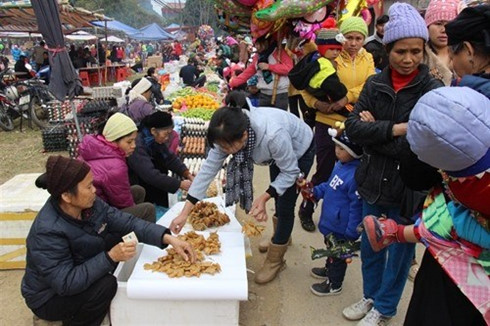A season for unusual culinary discoveries
It also happens to be the best season for visitors to discover many culinary specialties, some of them more uncommon and unusual than others.
 |
Ho Chi Minh City resident Nguyen Kieu Lam and her two sons recently visited the northern province of Cao Bang. They wanted to see the famous, historic Pac Bo cave and the Ban Gioc Waterfall. A couple of festivals at the King Le and Na Sam temples were also part of their itinerary.
“We enjoyed the beautiful landscapes everywhere, but what stands out for us as most special are the tasty dishes served by the Tay or Nùng ethnic minority vendors at traditional festivals,” Lam said.
She said her two sons could not have enough of a dish called lon quay (roast pig). The pieces were soft and its golden red or reddish brown skin so crispy that they wanted to eat more even after finishing of a large portion.
Lam’s elder son Ho Nguyen Ngoc said it was the first time that he was enjoying such an aromatic and tasty dish, the fragrance of the dipping sauce made with mac mat leaves (a kind of wild wampee tree found in the province) making it very special.
He asked Nong Ich Lai, a Tay man in Hoa An district (about 15km from the downtown Cao Bang city), to please reveal what made the dish so irresistible.
Lai, who has sold lon quay for more than 20 years at festivals in his district and in the city, was kind enough to indulge Ngoc.
Lai said that before Tet arrived, he would go to remote communes in Nguyen Binh district to buy organic pigs of about 20-25kg per pig each and raise them at home.
“I mix the mac mat leaves with dried onions, garlic, fish sauce, salt, and a pinch of traditionally made spice and put all the dumplings in the pig’s belly and sew it well before pouring a small cup of wild honey on the pig.”
He said roasting technique was rather difficult. The pig had to be turned regularly over a wood charcoal fire for about three hours. If it was not done properly, the pig could get burned, the meat could become dry and the skin would not be crispy.
Apart from lon quay, Lam and her sons also tasted ngai cuu and mo me xu hec cakes made by the Tay and Nung ethnic groups in the province.
Lai’s neighbor Doan Thi Huyen, a famous wampee cake maker in the district, got the recipe from her grandmother.
“I have to wake up very early in the morning to pick up the wampee fruit from my garden to ensure its freshness and then boil it in a special “ashes water” for between two and three hours until it is well-cooked.
“Then the ngai cuu leaves should be carefully washed and then mixed with glutinous rice powder. The cake’s dumpling is a mix of ground fried black sesame and cane sugar,” Huyen.
The cake can be steamed or fried, but steamed is healthier, she said.
Lam said she enjoyed the cake’s combination of fragrant glutinous rice powder and the special flavor of ngai cuu leaves “so much.”
“I could feel it cooling my body and satisfying craving taste,” Lam said.
Local herbalist Ta Ngoc Oanh, 70, said the leaves are particularly good for pregnant women and the elderly.
The leaves, apart from being nutritious, help reduce pain from injury, provide relief from itching, and is good for treating colds and headaches, as also improve blood circulation, Oanh said.
“I’ve used the leaves to treat my patients, and many of them with these ailments have recovered,” he said, reiterating that the ngai cuu cake is very good for human’s health.
Oanh’s wife, Nong Thi Tieu is famous for her mo me xu hec, a traditional cake made by the Tay and Nung people.
This cake is also made from glutinous rice but knead into the shapes of animals such as buffalo, cow, pig, dog, cat, and bird. After kneading and shaping, the cakes are pan fried either in vegetable oil or pork fat. The crispy, chewy and sweet taste makes these cakes very popular at local festivals.
Tieu said her mother taught her to make to the cakes when she was a little girl. “It sells particularly well at festivals. Children enjoy it a lot.”

